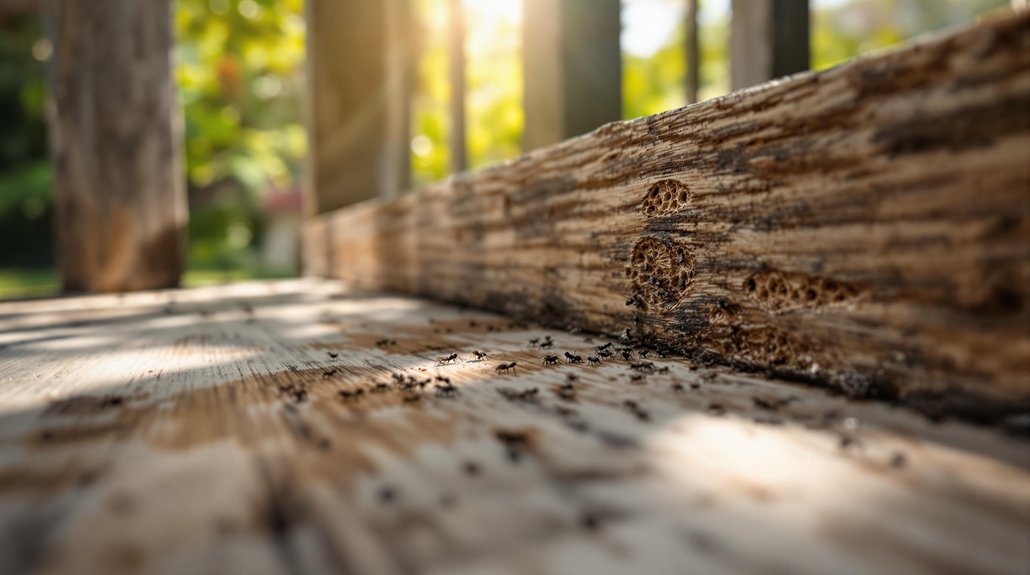In Austin, regular pest control is important due to the active pest landscape year-round. Warmer months see an increase in pests like mosquitoes and roaches, while spring brings ants and termites. It is beneficial to schedule inspections and treatments at least every season or more frequently if there are signs of infestations. This proactive approach protects property and health. For more details on pest control frequency and benefits, further exploration will provide valuable insights.
Key Article Highlights
- Monthly pest control services are recommended during warmer months due to increased pest activity, especially for mosquitoes and roaches.
- Quarterly treatments may suffice during cooler months, with reduced pest activity, particularly in winter.
- Regular inspections are crucial for early detection and tailored treatment plans based on pest severity.
- Seasonal treatments are often necessary for specific pests like ants and termites, especially during spring.
- Professional assessments can help determine the ideal frequency of pest control tailored to individual needs.
Understanding the Pest Landscape in Austin
Understanding the pest landscape in Austin requires awareness of the various types of pests that thrive in the region. Many pest species, such as ants, roaches, and termites, find a suitable environment in urban settings. Additionally, urban wildlife plays a significant role in this dynamic. Animals like raccoons, squirrels, and opossums often invade residential areas, seeking food and shelter. Their presence can lead to conflicts with humans and create pest management issues. The diverse climate of Austin contributes to the year-round activity of these pests. Homeowners must recognize these challenges to implement effective pest control strategies. Routine inspections and awareness of local pest species and urban wildlife is essential for maintaining a safe and healthy living space. To effectively manage these issues, homeowners should consider integrated pest management methods that include chemical treatments and exclusion techniques. Proper sanitation and exclusion repairs are crucial in preventing rodent access and eliminating activity.
Seasonal Pest Activity Patterns
As temperatures change throughout the year, pest activity in Austin fluctuates considerably. Understanding seasonal pest migration patterns helps residents prepare for potential infestations. Warmer months often see an increase in pest populations, while colder months lead to a decline. Climate impact plays a significant role in these patterns. Effective termite control methods, including liquid soil treatments, can help mitigate the risks associated with seasonal pest activity. Additionally, implementing mosquito control strategies can significantly reduce the population of these pests during the summer months. Regular inspections and heat treatment can also be crucial to manage hidden infestations effectively.
| Season | Common Pests | Activity Level |
|---|---|---|
| Spring | Ants, Termites | High |
| Summer | Mosquitoes, Roaches | Very High |
| Fall | Spiders, Wasps | Moderate |
| Winter | Rodents, Bugs | Low |
Awareness of these seasonal trends can guide pest control efforts, ensuring timely interventions and effective management in Austin’s unique climate.
Factors That Influence Pest Control Frequency

Several factors affect how often pest control is needed. The type of pest, seasonal changes, and the location of the property all play important roles. Understanding these factors can help homeowners manage pest issues more effectively. Additionally, employing residual sprays and other treatment methods can enhance the effectiveness of pest control efforts. For instance, effective control of fleas, ticks, and chiggers often involves addressing shaded yard areas and pet bedding both indoors and outdoors.
Type of Pest
Pests come in many forms, each affecting the need for control differently. The type of pest present in a home or business can greatly influence how often pest control is required. For instance, different ant species may invade spaces at various times, leading to unique challenges. Carpenter ants, for example, can cause structural damage, requiring more frequent inspections. On the other hand, some ant species may only need occasional treatments. Additionally, rodent behavior plays a vital role. Rodents reproduce quickly and can create significant health risks if not controlled promptly. Understanding these differences helps determine the right pest control frequency, ensuring effective management and protection from potential infestations.
Seasonal Changes
Seasonal changes greatly impact pest behavior and activity, which in turn affects the frequency of pest control needed. Different seasons bring various seasonal pests that thrive in specific climates. For instance, warmer months often see an increase in insects such as mosquitoes and ants, while colder months may lead to rodents seeking shelter indoors. The climate impact also influences pest life cycles, making some pests more active during certain times of the year. Homeowners should be aware of these patterns to effectively manage pest control. Regular inspections and treatments may be required during peak seasons to prevent infestations. Understanding the relationship between seasonal changes and pest activity is essential for maintaining a pest-free environment.
Property Location
Property location plays an essential role in determining how often pest control is needed. Properties situated near green spaces, parks, or wooded areas may experience more frequent visits from urban wildlife, such as raccoons and squirrels. These animals can introduce pests like ticks and fleas into homes. Additionally, properties in urban settings may face different challenges, including more common infestations like cockroaches or rodents. Regular property maintenance is vital in these locations to reduce pest attraction. Keeping yards free of debris and ensuring proper waste disposal can help minimize pest problems. Understanding the local environment and its potential pest influences allows homeowners to tailor their pest control efforts effectively, ensuring a safer and healthier living space.
Signs You Need Pest Control Services

How can one tell if it’s time to seek pest control services? There are several signs to watch for that indicate a pest problem. Homeowners should utilize pest identification techniques to recognize the presence of pests. Common signs include droppings, gnaw marks, and unusual noises.
| Signs of Pests | Action Needed |
|---|---|
| Droppings found | Inspect and identify pests |
| Gnaw marks on surfaces | Contact pest control |
| Strange noises at night | Assess and act quickly |
Implementing pest prevention strategies can help maintain a pest-free environment. Regular checks and monitoring can assist in early detection, making pest control services more effective when needed.
Recommended Pest Control Schedule
Recognizing the signs of a pest issue is only the first step in maintaining a pest-free home. A recommended pest control schedule is essential for effective pest prevention strategies. Many experts suggest quarterly treatments as a reliable approach. This frequency helps in addressing potential infestations before they become serious. Additionally, homeowners should consider seasonal changes that may affect pest activity, adjusting their schedule accordingly. Common pest control myths may lead people to think that treatments are only necessary when pests are visible. However, proactive measures can save time and money in the long run. By adhering to a consistent plan, homeowners can enhance their defense against pests and maintain a safe living environment.
Benefits of Regular Pest Control Maintenance
Regular pest control maintenance offers peace of mind for homeowners. It helps to prevent infestations before they start, ensuring a safe living environment. This proactive approach leads to cost savings, as it is often cheaper to maintain pest control than to deal with a major infestation. Regular visits from pest control professionals can identify potential issues early, reducing the need for expensive treatments later.
Additionally, there are significant health benefits associated with regular pest control. Pests can carry diseases that threaten the health of families. By keeping these pests at bay, homeowners can protect their loved ones from harm. Overall, regular pest control maintenance is an investment in safety, comfort, and financial well-being for any household.
Frequently Asked Questions
How Can I Prevent Pests From Entering My Home?
Preventing pests from entering a home is like building a fortress against invaders. Implementing preventive measures, such as sealing entry points, maintaining cleanliness, and using barriers, can greatly reduce the likelihood of unwanted visitors.
What Are the Costs Associated With Pest Control Services?
Pest control pricing varies based on service frequency and type of pests. Basic treatments may cost less, while ongoing services for severe infestations require higher investments. Homeowners should consider their specific needs when budgeting for pest control.
Are DIY Pest Control Methods Effective?
In the garden of pest management, DIY methods bloom with potential. However, a careful effectiveness comparison reveals that natural remedies may succeed against minor infestations, yet professional services often outperform in tackling larger, persistent pest issues.
How Do I Choose a Reputable Pest Control Company?
Choosing a reputable pest control company involves checking customer reviews and evaluating service guarantees. A trustworthy company should have positive feedback and offer assurances for their services, ensuring reliability and effectiveness in pest management.
What Should I Expect During a Pest Control Treatment?
During a pest control treatment, one can expect a symphony of methods tailored to various pest types. The treatment process often involves inspection, application of solutions, and guidance on maintaining a pest-free environment thereafter.

